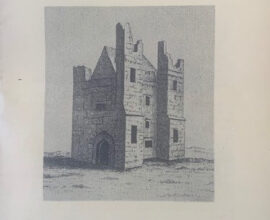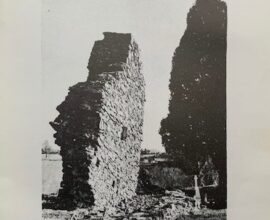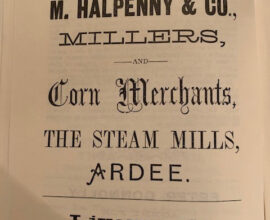75 women and girls who left Ardee for America in 1855
On Tuesday 3 September 1861 the people of Ardee and the surrounding countryside assembled in the Market Square of the town to witness the unveiling of a colossal memorial to the Foster Family of Glyde Court (near Tallanstown). Two questions immediately arise. The first is why did Ardonians, when Ireland at the time was embroiled in a land war and where the landlord class was blamed for the catastrophic events of the Famine, erect a monument to members of the landlord class? The second question is what has the unveiling of this monument got to do with International Woman’s Day?
In seeking answers to these one quickly becomes aware of the connections between the Foster family, women from Ardee and the United States of America.
It was the head of the Foster family, Augustus, who originally established the link to the USA when, at the turn of the Eighteenth Century, he was posted as a staff officer to the British Envoy at Washington. He quickly rose through the diplomatic ranks and was befriended by no less a person than President Jefferson. Little did he know at the time that the connection between the United States and his family were to last for almost the next 100 years.
While Augustus had established the link between his family and America it was two of his sons, Vere (1819-1900) and Frederick (1815-1857), whose philantrophic efforts during the Famine, particularly in their assisted emigration schemes to America, that caused an appreciative Ardee people to raise a memorial to their honour in the town in 1861 (Whereas the inscription on the monument specifically mentions Frederick it is a given that it was for Vere’s efforts as well).
Both Frederick and Vere’s early careers were in the Diplomatic Corps but it was during the Great Famine of 1845-1850 that they came to worldwide prominence. Frederick settled on his father’s estate at Glyde Court where he became a ‘wise and benevolent’ landlord. He remitted rents in cases of hardship and advanced seed to those unable to pay for it. When such palliatives became inadequate he and his brother Vere expended their fortunes in assisting people, especially women, to emigrate to the United States of America. Frederick remained at Glyde Court while it was Vere who did all the travelling and this is perhaps the reason that Frederick is named on the memorial.
On 26 October 1850 Vere boarded the largest emigrant ship then afloat, the Washington, for the voyage to New York. His intentions were twofold; to experience firsthand what emigrants had to endure in crossing the Atlantic. He also wished to explore the possibilities of employment that might be had for the women that he and his brother were going to send there. He was well received there by political leaders who had remembered his father before him. He spent over a year travelling throughout the land making contacts and investigation opportunities for the women he was about the send there. It was his intention not just to ship the women there but to also advise and assist in getting employment opportunities for them. This is what made the Foster assisted emigration schemes unique as they encouraged the emigrant to leave the seaside ports as soon as possible instead of ‘lounging away their time and sticking like glue in the large cities’. Other schemes literally dumped the emigrant at the ports they disembarked to.
On his return to Ireland Vere and Frederick established the Irish Female Emigration Fund to assist the emigration to America of one able-bodied female from each family specially selected on ‘account of her poverty, good character and industrious habits’ with the expectation that the women would, in turn, take the remaining members of her family out of poverty by sending money back to Ireland to either pay the rent or to take further members of the family over to America.
This was the beginning of countless sailings of emigrants from Ardee and surrounding areas, funded mainly from the personal fortunes of Vere and Frederick. Vere also went to the trouble of escorting these Ardee women, not only to the ports in America but he also travelled with them into the interior, not leaving them until he was assured that they had settled into the employment he had obtained for them. One such expedition left Ardee in early 1855 where, according to a local newspaper, ‘On Monday morning last Vere Foster, Esq., left Ardee with about seventy female emigrants. About twenty of them had been inmates of the Ardee Union Workhouse, the remainder were from the town and surrounding country – they were all decently clad with comfortable clothes. The procession as it moved along the road, with the worthy gentleman mounted on a common dray amongst his protégées reminded us forcibly of the patriarch Jacob on his journey to the land of Goshen’. We confess, however, that it is a sight which must be anything but in unison with the feelings of Irishmen. It shows that there is ‘something rotten in the state of Denmark’ when our rural population are thus obliged to be annually expatriated. It certainly is not for want of the raw material to employ them, as our island, if properly managed, could employ and sustain double its present population. We think if this wholesale exportation of the bone and sinew of the country is permitted to go on thus annually that it will in the long run be the cause of regret to all classes of society’ (Drogheda Argus 17 May 1856).
The names and ages of these woman are appended below.
In May 1857 another party of 120 women left Ardee. After putting them aboard the sailing ship, the City of Mobile, Vere himself sailed to New York by steam in order to complete plans for their reception. Vere met the ship on its arrival in New York but found, that despite his warnings, four of the women had been taken to work in a brothel by the sailors who had promised them great wealth. He accompanied the remaining 116 women into the interior. At various stopping points Vere and his party were met by Parish Priests or persons of Irish descent, who took the women into care until positions were found for them. On one of these stopovers Vere and the remaining Ardee women found themselves at Springfield where, ‘a distinguished lawyer had most kindly offered to give a home to some of the women’. This was no less a person than Abraham Lincoln and Vere and his party found themselves staying overnight with the future President and his wife.
On returning to Ardee Vere brought with him many letters and messages from Emigrant Ardee women to their families who they had left behind in the town. Vere himself describes a particular message he himself conducted. ‘On my previous trip I had asked one of my emigrants in America if I could execute any commission for her on my return to Ardee. She asked, do you know the big tree at Mullacurry, between Ardee and Dromin? I replied, quite well. She then said, I spent many a pleasant day under that big tree and if you would bring me out some of the clay from under its roots I would be greatly oblidged to you. I, therefore, now diverged from the high road, borrowed a spade, filled a flower pot with the desired clay, put garden mould on the top, and stuffed it cram full of shamrock and brought ir to America on my next voyage’.
The newspaper report into the 1855 sailing shows what some people in Ireland were thinking, that these women should stay and work in Ireland and that it should be males and not females who emigrated. It was not long before the Catholic Church began to complain and further stir tensions into the motives of Vere and to what may be happening these women on arrival in America. They made particular reference to the four women who ended up in a New York brothel. Some families in Ardee where still unconvinced that their daughters were safe so Vere responded by bringing back with him as many letters as he could from the Ardee women whom he had assisted to emigrate and, in May 1858, he rented a shop in Castle Street in Ardee and, along with the letters that were there for collection, he put on display daguereotype images (the photos of the period) of almost all of the original 75 women who left Ardee. You can imagine the delight of Ardonians who came into the shop that day to witness their loved ones’ images and read their letters. These are now in the Foster Manuscripts in the Public Record Office of Northern Ireland.
Frederick died in 1857 but the philanthropic work was carried on by Vere, in emigration, education and hospitals until he died penniless and homeless in 1900.
For International Women’s Day Ardee should salute and remember these brave 75 women who were the first to leave Ardee for the unknown of the New World. They were not the last as many other women made the journey with Vere Foster to the shores of America. Whereas these were, to a certain extent voluntary, there were many more other women in the Workhouse in Ardee who were forcibly put on ships for journey to Australia.
The names and ages of the 75 women who left Ardee for America in 1855
Barton Alice, 20 Bellew Maria, 16 Brady Anna, 16 Brady Catherine, 16 Brady Mary, 20 Brady Rose, 18 Byrnes Catherine, 20
Byrnes Ellen, 18 Campbell Anne,16 Campbell Mary, 19 Campbell Mary, 16 Carney Bridget, 22 Carroll Mary, 19 Carrollan Catherine, 18
Carry Biddy, 16 Clarke Mary, 25 Coleman Margaret, 16 Condra Anna, 22 Conlon Anne, 17 Connor Mary, 16 Creaton Catherine, –
Cummerford Mary, 21 Cunningham A 20 Cunningham Bridget,20Drumgoole Margaret, 20Duffy Anne, 18 Duffy Anne, 18 Duffy Elizabeth, 20
Durnin Mary, 16 Flanagan Ellen,18 Gaherty Mary, 16 Gartland J. 25 Gartland Mary, 22 Green Mary, 17 Grimes Bessy, 16
Grimes Catherine, 17 Hand Jane, 14 Kernan Ellen, 17 Lamb Mary, 20 Mackle Margaret, 18 Malone Margaret, 16 Malone Mary, 20
Marron Rose, 20 Mathews Margaret, 37 Mathews Margaret, 14 Mathews Mary, 20 McArdle Margaret, 17 McCanna Margaret, 21 McCormack Catherine, 20
McDonald Mary, 21 McIntegart Eliza, 16 McLean Catherine, 18 McNeill Anne, 14 Meade Anna, 17 Murphy Bridget, 23 Murphy Jane, 21
Murphy J 21 Murphy Mary, 22 O’Brien Catherine, 16 Reilly Margaret, 17 Reynolds Essy, 18 Rogers Anne, 26 Sanders I, 22
Shallcross Henrietta, 6 Sheridan P, 26 Skelly Catherine, 18 Smith Catherine, 16 Smith Kate 20 Taaffe Anna, 15 Tiernan Jane, 18
Victory Anne, –





Well done with your article on Frederick and Vere Foster. Upon my retirement as General Secretary of the INTO I embarked upon a research project with a view to promoting and commemorating the legacy and memory of Vere Foster, who had been invited to become the first President of the INTA (later the INTO) when teachers initially came together in 1868. I have collated over 2,500 files on Vere Foster containing amongst them paper clippings, articles, and internet information. I have lists of Passengers from the Lady Franklin, the Calhoun and Orient ships collated by Brendan Hall in 2001 of the women who went to America and Canada in 1856. I was particularly interested in the source of your list of Adree women who embarked upon their journey to America in 1885. Perhaps you would be good enough to direct me to the source of your research. Although my main interest lies in researching Vere’s contribution to education in Ireland in the 19h century, his emigration period is also very relevant to my project. I also have a list of the women who arrived with Vere in Janesville, Wisconsin. A guy called Haldiman intended making a documentary on the Janesville descendants of Irish emigrants, but the project fell through due to lack of funding. Again, well done and looking forward to hearing from you